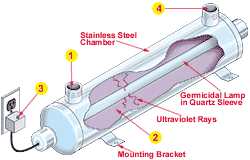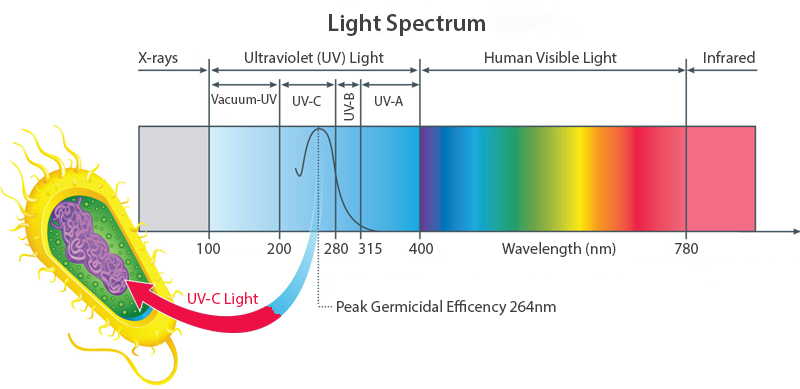Ultraviolet Light for Water Treatment System
Unlike chemical approaches to water disinfection, Ultraviolet light (UV) provides rapid, effective inactivation of microorganisms through a physical process. When bacteria, viruses, pathogen and protozoa (like cryptosporidium and, giardia) are exposed to the germicidal wavelengths of UV light, they are rendered incapable of reproducing and infection.

It is very important to shield the UV light lamp from sediment in the water (typically with at least one sediment type filter before the UV system), ensuring the most effective use of the UV light. If there is no sediment filter(s) then the quartz tube protecting the UV lamp will become dirty and the UV light won’t be able to treat the water properly.
Even though the Ultraviolet Light (UV) bulb can emit light and appear to shine bright, but they are not. Every day of use UV bulbs loses intensity. They are rated for bacteria inactivation for 12 months. After 12 months the bulb will need to be changed. Even if the light is on or still lights up, it is not putting out the same intensity as it was when it was new.
All UV lamps will need to be changed annually. They may not be effective past the 12-month.
The Need to Change Your Ultraviolet Light Bulb Annually
The key to Ultraviolet light (UV) disinfection is that different amounts of UV-C energy are needed to inactivate different nasty bugs or organisms. The amount of energy needed is known as the dosage. And like a dose of medication, you need to determine how much will be effective. For a UV system, you get the dosage by multiplying the light intensity by the exposure time. The exposure time is determined by the flow rate of water through the UV chamber. And the light intensity is primarily set by the lamp designer and the quality of the lamp.
Manufacturers of UV systems will typically design the system to provide a dosage of 30 m J/cm2. This is sufficient to inactivate the microorganisms commonly found in water supplies. The dosage is typically guaranteed for about 9000 hours or around 12 months of non-stop operation. After that, the lamp will need replacing.
Why? Because the UV-C intensity degrades over time, much the same way that the potency of a medication diminishes over time. Continuing to use your UV lamp over the recommended 9000 hours is like taking medication after its expiry date. Just because it’s in your medicine cabinet doesn’t mean it will work to protect your health. And so just because the UV lamp still lights up then it doesn’t mean it will protect you…
Many UV systems are equipped with a countdown timer or other visual prompt or even a light or alarm to alert you that it is time to change the UV lamp.
For more information on UV whole house systems please call us on 1800 268 469 or visitor our Whole of house web page for more information.

